
Today I am going to introduce you to the unholy coupling of business consulting and relationship advice that is Strategic Planning for Couples.
How This All Started
Late last year, my partner and I started talking more seriously about our future together, and I had a brilliant idea:
Take what I do for companies and teams, and apply it to the relationship.
And hence, Strategic Planning for Couples was born.
I mean… what could possibly go wrong… right? 🙈🙊🙉
People talk about #couplesgoals on social media, but that’s just an idea. Very few have a framework for how to turn that into reality.
In my work I speak with a lot of business people and a surprising number of them do a similar planning process, or have expressed great interest in doing something similar in their relationship.
In fact, the topic was in such high demand, that I gave a talk about it at a recent business conference.
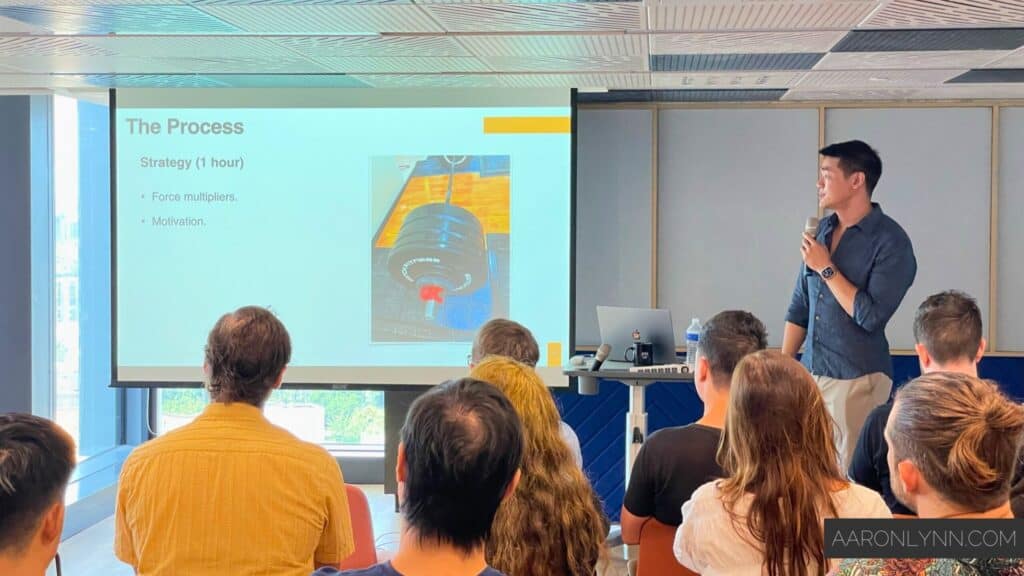
But first, a warning:
This is not something you do with a casual boyfriend or girlfriend.
This is a process you do with someone you’ve chosen to be your life partner, and who you have a commitment to long-term goals together with.1In fact, that’s what I believe makes long term relationships work. Underneath all the love, intimacy and couply ideals, it’s an understanding that you have shared long term goals together, that make a relationship or marriage work.
By the end of this, you will know how to strategically plan with your significant other, and as a bonus, you will also know how to strategically plan for your business as well.
First Attempts
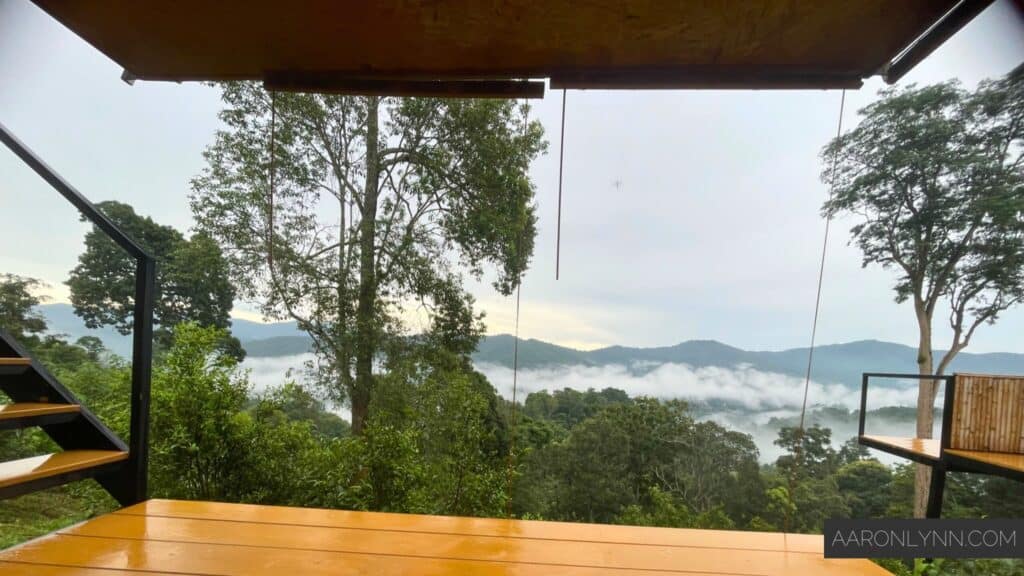
My partner and I have talked about “planning for the future” for a couple of years now.
But it was largely just talking with sporadic amounts of doing.
It took us a while to begin the process of formally planning because we are both business people workaholics. And as you know, business people tend to prioritise work over everything else, including their relationships.
The first strategic planning session we completed was in Chiang Mai, Thailand.
We had picked out a scenic, remote mountain cabin, hoping to be inspired by the nature around us as we talked about the future, goals, and KPIs.
But about an hour after we arrived, we smelled smoke in our cabin.
We looked outside, and it turns out the lychee farm next to the resort was burning their crops.
And so within about two hours of our arrival, ourselves, our cabin and our clothes and belongings, all smelled like smoke.
So we decided to cut the stay short, called our driver back and headed back to the Nimman area of Chiang Mai city the next morning.
We then spent the next few days at the Maya CAMP co-working space, and used a whiteboard and our laptops to produce this document:
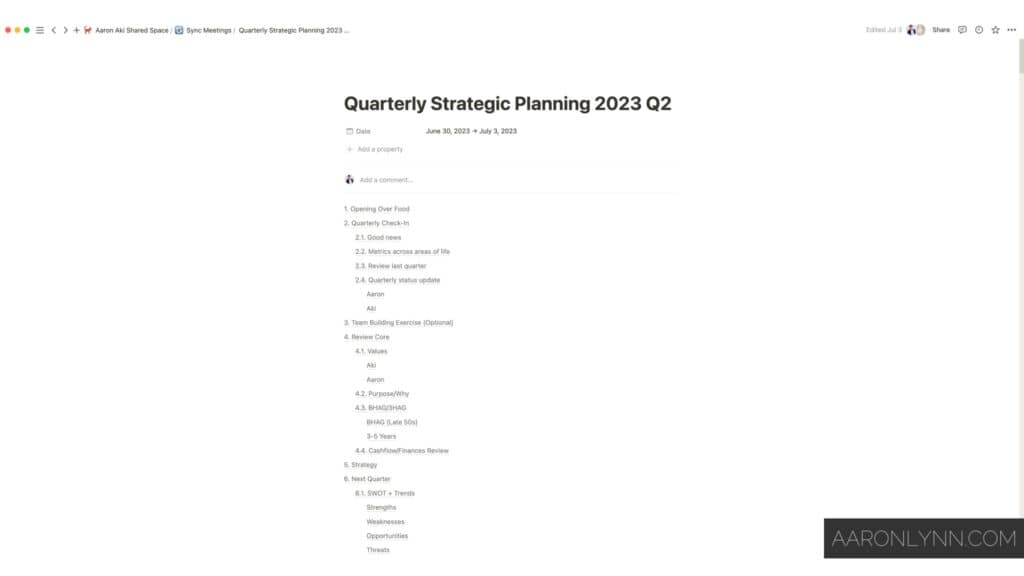
And that was our first attempt at strategic planning as a couple.
Subsequent Attempts
Our second attempt was substantially better.
Out of our first experience in Chiang Mai, we had learnt that the location should be:
- Offsite, away from your usual environment and work.
- Nice, meaning inspiring natural scenery or cityscapes.
- Practical, meaning Wi-Fi and a whiteboard/tablet to work on.
We wanted to pick somewhere nice, but practical, and settled on a resort at Sun Moon Lake in Taiwan.

Our subsequent attempts since have followed that same format:
- Good location, offsite.
- Natural scenery and/or cityscape.
- Accessible food, coffee/tea and areas for “break out sessions” and breaks.
The Couples’ Strategic Planning Agenda
Here is the agenda for Strategic Planning for Couples.
Agenda
- Opening over food: Top 3 issues and themes.
- Review last quarter: Good news, metrics, review, status update.
- “Team building”.
- Core: Purpose/why, values, 5-year/10-year vision, cashflow and finances.
- Strategy.
- Next quarter: SWOTT, quarterly objectives, critical numbers/KPIs.
Let’s break this down in detail.
Three Days of Strategic Planning
The entire process takes three days. This is plenty of time to complete your strategic planning in.
If pressed for time, you could fit it into 2.5 days, but this isn’t really a process that you should rush.
This allows you to have a nice vacation for you and your partner every quarter, which is just pure couples/relationship time.
I recommend beginning to discuss the planning, agenda and topics as you begin your trip — this will kickstart your creativity and planning faculties for the session.
Day 1 consists of dinner the night before.
Day 2 is when most of the planning happens.
Day 3 is where you complete anything left over, and share any afterthoughts together.
It is also recommended to postpone all your other commitments during the planning session, and just focus 100% on the planning. It isn’t fun to have to hop on Zoom calls or reply to emails and Slack messages while you’re planning your future together.
1. Opening Over Food
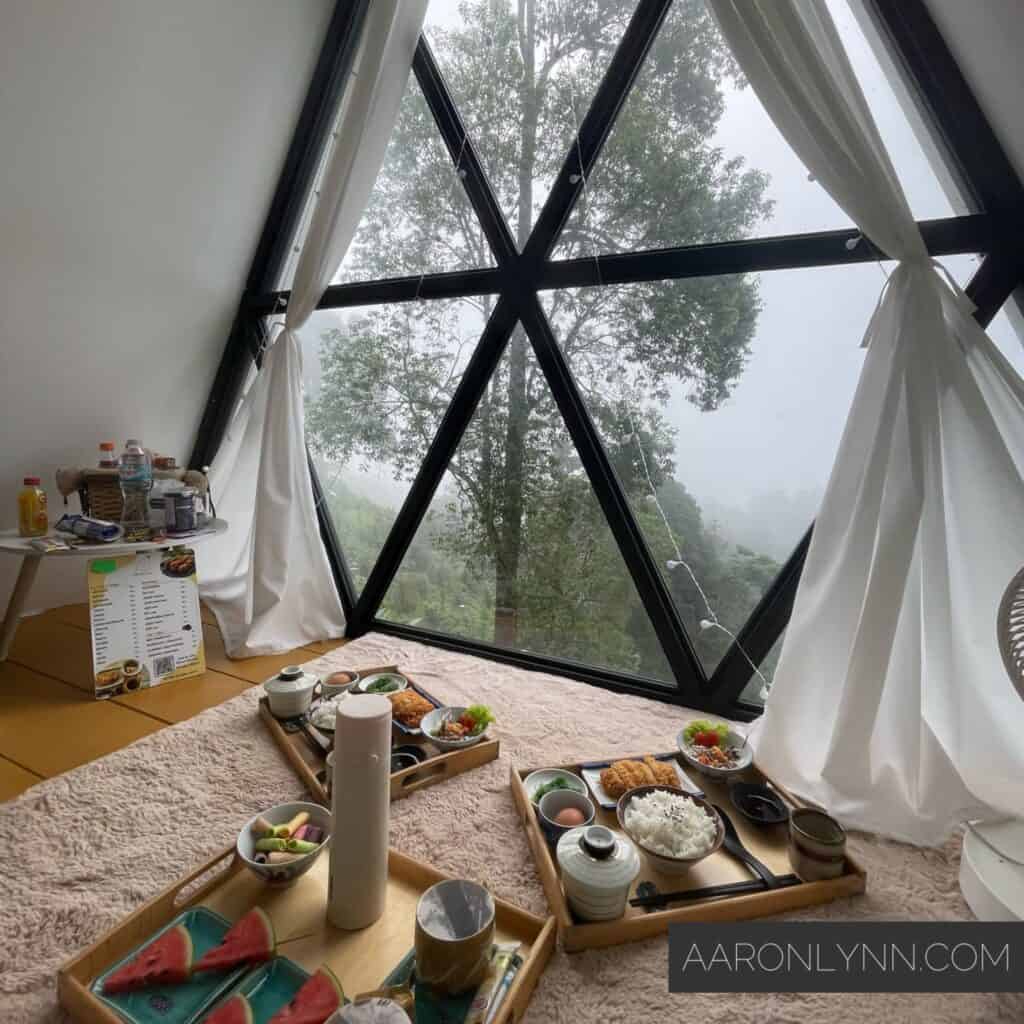
The strategic planning session should kick off with a dinner for yourself and your partner, discussing your top 3 issues and themes.
The top 3 issues are ideas you have independently prepared and thought about before the session, and want to discuss with each other. These do not have to be “serious” topics, but can be issues in the relationship, issues in life or anything really that affects the both of you.
Themes are best thought of as philosophical seasons. The objective with these is to create alignment — to be on the same page with your partner about where your lives are at the moment.
Is your life currently in a growth-inducing summer, or a declining winter?
The first time that my partner and I did this was at the mountain cabin in Chiang Mai. Despite the venue not being the best, we still managed to cover both our top 3 issues that we wanted to discuss with each other and our themes.

The second time we planned this much better, having a succulent Chinese meal at the resort at Sun Moon Lake.
2. Review Last Quarter

The first item on the agenda for Day 2 of your strategic planning session should be a review of the last quarter (3 months).
This is straightforward.
First, share any good news with each other:
- What were your wins and accomplishments and lucky breaks over the last three months?
- Include things that happened both intentionally and unintentionally.
Second, review any metrics for the last quarter. This will mostly be around health numbers (weight, body fat), and finances (income, expenses, other financial metrics you track).
Finally, finish up with a combination review and status update.
If you had goals written down for the quarter, share how they went. If not, do a “status update” and talk in general terms how the quarter went at a high level.
3. “Team Building”
When a consultant runs a strategic planning session for a business team, the “team building” section is usually an exercise where everyone shares a childhood story, or a “here’s one fact you would never guess about me” snippet.
With your partner, there is only one type of team building that counts:

Just kidding.
The first time we wrote this into our agenda and came across it, we had no idea what to do. So we went to eat:

The second time we figured that the best “team building” for couples would be an open discussion over tea and food. So we went downstairs to the koi pond, ordered some oolong tea and snacks and talked unscripted.

4. Core
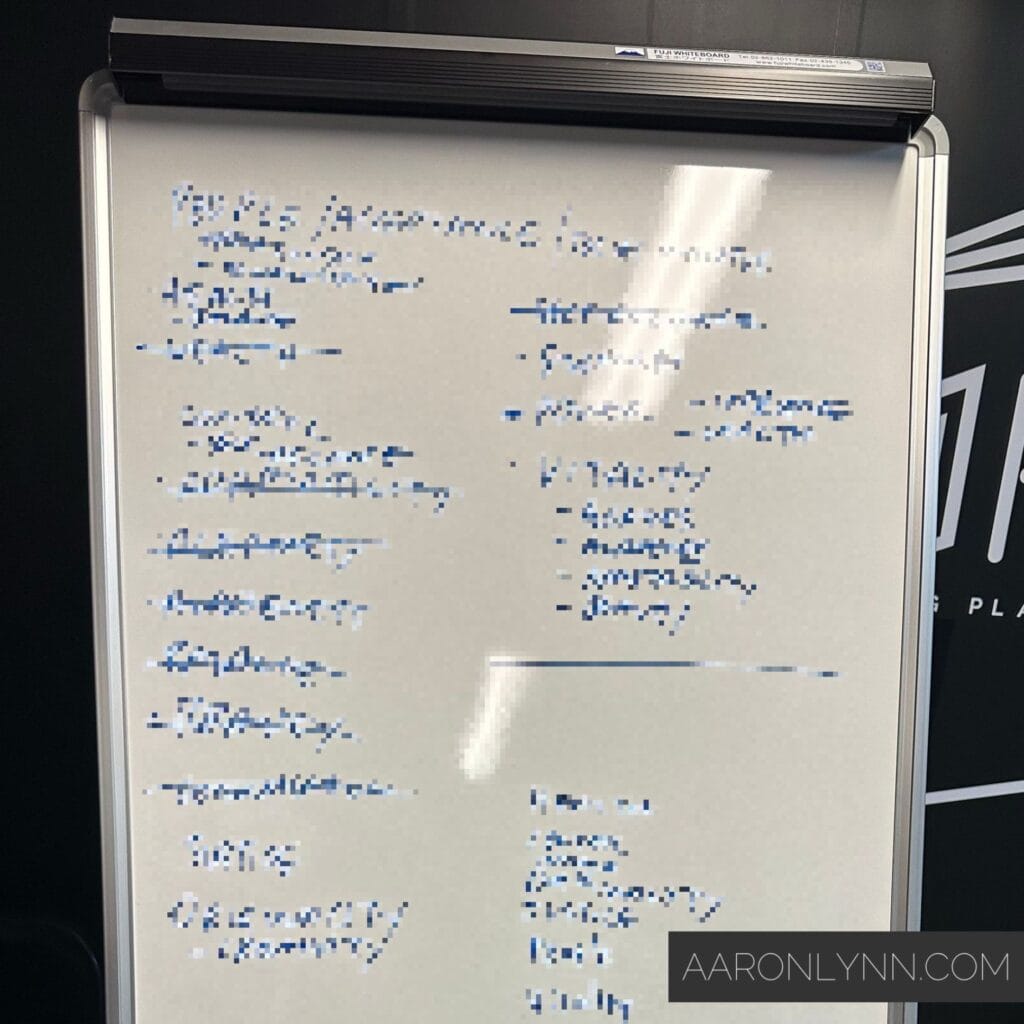
The “core” in a business strategic planning session is a review and elicitation of the company culture.
Why does the company exist?
What does the company value, and what does the team agree to adhere to at work?
What are the big, long-term goals?
For couples’ strategic planning, it is largely similar.
You begin by discussing each other’s purpose/why: What are your purposes in life?
The first time my partner and I did this, we “knew” each other’s purposes, but had never formally written them down.
It turns out Aki’s purpose is Creativity.
Mine is Evolution — pushing myself and others to the next level, then the one after that, and so on.
Once you’ve written down your purpose the first time, you can simply review it in future sessions to see if anything has changed.
The next step after purpose are your values.
Here is my process for deriving core values.
During our first strategic planning session, neither Aki nor I knew what her core values were, so we went through the exercise above and elicited them.
I had no idea that her top value was health, and that “influence” and “justice” were on her values list.
In my case, I have always known what my core values are — but Aki pointed out to me that I was missing a core value that would allow me to relate to people.
So we created one called “Connections” for me, and I have been heavily living it since. In practical terms, it is proactively organising to meet with 1-2 people per week every week, resulting in substantial growth for my network and friends group.
Once you have your purposes and values written down, you can discuss your 5-Year and 10-Year Visions.
In business, these would be your BHAG and 3HAG. Your BHAG is your big, hairy, audacious goal. A long-term, 20-year vision for the company that it will likely never reach. The 3HAG is a 3-year, highly achievable goal that the company will 100% hit if it stays on track.
For a couple, we turned this into 10-year and 5-year visions.
We sat down, and described every aspect of our lives for the 10-year mark and 5-year mark. Everything from the time we would wake up in the morning, to going to sleep at night, across different weeks, months, years.
There was a lot of discussion about how our visions lined up, and how they didn’t line up.
This will only be lengthy the first time that you do it. From your second planning session onwards, this step is usually just a review and adjustment of the visions you have written down before.
The last part of your core are your cashflow and finances.
We talked about our assets, income, expenses, and liabilities.
Despite both being financially responsible, this isn’t something we had ever done as a couple before.
And much like your purpose, values and visions, once you have done this once, you will have a baseline for future comparison.
5. Strategy

In a business strategic planning session, Strategy is where you would bring out models like balanced scorecards, ICPs and five forces to come up with a better strategy for the company.
For a couples’ planning session, you need to be creative.
What we came up with were:
- Force multipliers.
- Motivation.
Force multipliers are actions or ideas that help accelerate other actions or ideas in your lives.
For us, this was, for example, sticking to our exercise habits, adding in more cardio workouts, eating healthier and the tactical usage of coffee and green tea.
We also discussed hiring coaches and specific business or professional skills areas.
Motivation was more about using each other’s brainpower to help solve motivation or mindset blocks. More on that here.
6. Plan Next Quarter
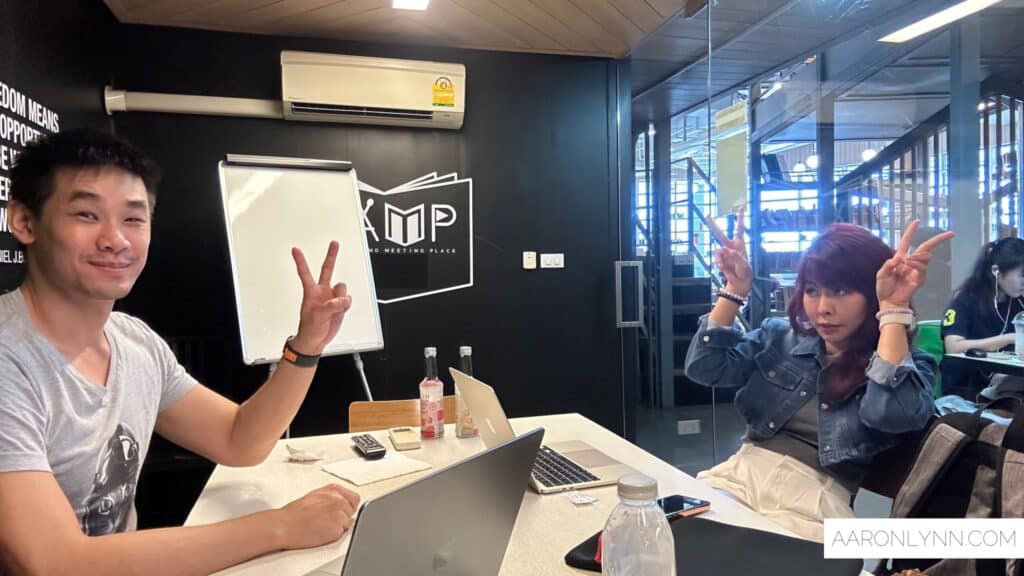
The last part of your strategic planning session is to set up the next quarter for success.
There are three items that should be done here.
The first is a SWOTT analysis:
- Strengths.
- Weaknesses.
- Opportunities.
- Threats.
- Trends.
You will want to run this as a couple, to see what may affect either or both of you in the upcoming quarter.
Trends are an addition to the traditional SWOT model that asks if there are any global or zeitgeist trends that you should pay attention to, even if they don’t impact you directly the way that opportunities and threats do.
The second is simply your upcoming quarterly objectives.
This is setting goals.
You want to have 3 individual objectives each, and then 1–3 couples’ objectives together.
This is because you are individuals with different jobs, businesses, hobbies, and interests. But you are also a couple. So it makes sense to have both.
If you don’t know how to set goals, you can follow my model here.
The last item is critical numbers and KPIs.
You want to attach metrics and targets to aim for to each of your objectives so that you know when they are “done” or not.
Following Through with Your Strategic Plan
Now that you have created a strategic plan for you and your partner, you may be asking:
What’s next?
There is absolutely no point in creating a plan and then leaving it on the shelf to collect dust until next quarter.
You need to follow through with this plan on a weekly basis, and there are two ways to do this.
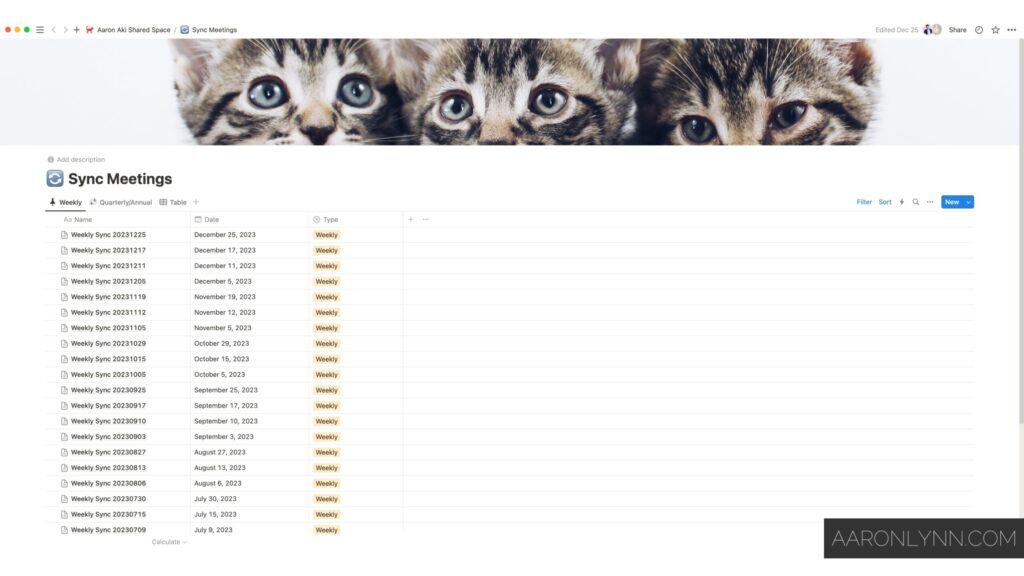
The first is with Weekly Sync Meetings.
These are run like a normal company weekly meeting:
- Good news.
- Discuss priorities (quarterly objectives).
- Status update.
- Clear issues.
- Action items.
My partner and I run these every Sunday at 11am, as it helps us prepare for the upcoming week.
If that time-slot is unavailable because of social or work commitments, we run it at a different time on Sunday.
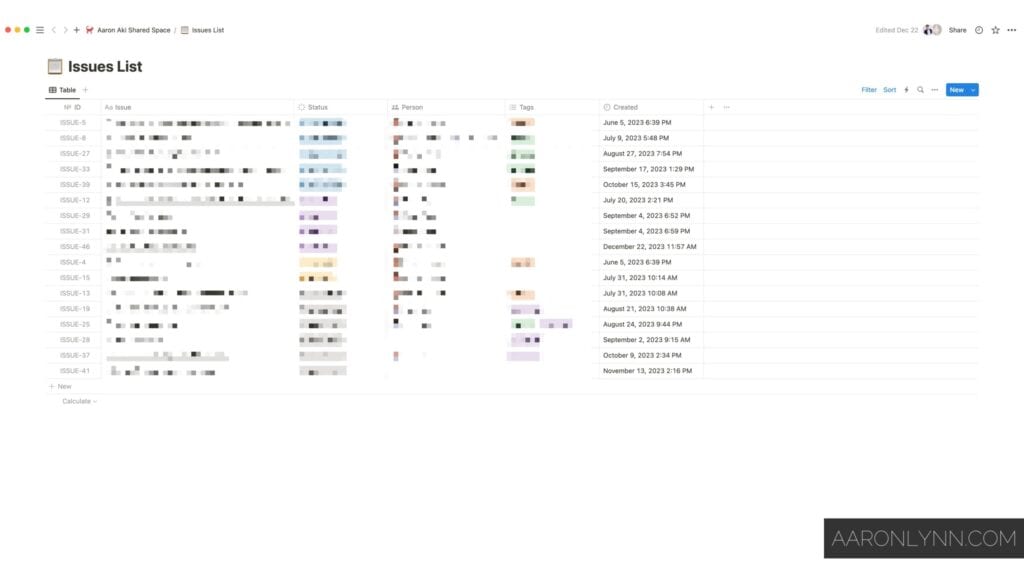
The second is with an Issues List.
This is for the “clear issues” item in the weekly sync meeting agenda above.
You will want to set up a joint issues list in Notion or another app, which is just a running list of issues you want to discuss with each other.
These issues could be related to your goals, or could just be items that need to be cleared. Examples include:
- Planning trips together.
- Helping each other with work and business.
- Mundane relationship items like buying a new car or sorting out a disagreement.
They should be listed and burned down, just like an issues list from EOS.
The last follow through item happens annually, which is that at the end of Q4, you should do an “Annual Strategic Planning for Couples” session, which is a longer, 1-week session for reviewing not only Q4, but the entire year. During this session, you will also set yourselves up for the following year.
Benefits of Strategic Planning for Couples

You may be wondering if it is worth taking three days out of every quarter to plan your long-term future with your partner.
Here are some benefits that my partner and I discovered in creating and using this process.
The first is that most couples never talk about any of this at all.
Having this process helps you and your partner uncover common relationship problems, resolve them, and even prevent them.
This is because most people get into a relationship without knowing what they want — they operate with trial and error.
They argue that any formal planning kills the romance, and refuse to structure how they relate to each other.
What that means is not only do they not know what they want — they also have no idea what their partner wants.
Holding strategic planning sessions together, addresses all of this and creates alignment between both partners.
Speaking of which, strategic planning is a way to structure your romance.
You see #couplesgoals plastered all over social media, and think “how lucky are they” without realising that there is a way to make those goals happen — with a bit of planning.
You too can have a successful relationship with fewer arguments, issues and drama, you just have to be willing to plan a bit.
The planning sessions and weekly follow through also serve as a reality check for the relationship. Your partner will give you real-world, real-market feedback if you said you were going to do something and didn’t follow through, or if it isn’t working out the way you thought it would.
This is a form of keeping each other accountable.
I know that seems super simple, but having a weekly sync meeting and having it written down that you haven’t progressed on a goal or task makes it SUPER OBVIOUS that a different approach is needed.
Lastly, by doing this, you will understand each other a lot better.
You will be able to positively manipulate your partner into doing things that are good for them.
You will understand what you have, what you don’t have, and what your partner has and doesn’t have as well. And you’ll be able to do all this through conversation, rather than through arguments and disappointment.
In this way, you will push each other to be better.
What To Do Next
Set up a time for the end of the quarter and do a couples’ strategic planning session with your partner.
If you want the agenda for the session, enter your name and email address below, and I’ll send it to you:
- In fact, that’s what I believe makes long term relationships work. Underneath all the love, intimacy and couply ideals, it’s an understanding that you have shared long term goals together, that make a relationship or marriage work.